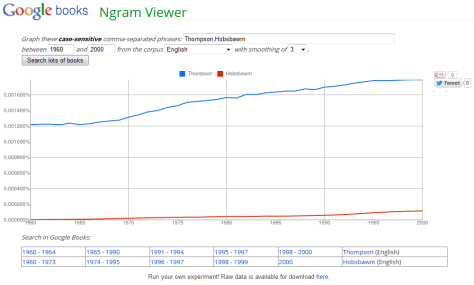This Thursday I rounded off a hat-trick of participation in teaching related events, with a talk at University of Kent‘s Faculty of Humanities Teaching Forum. This annual event – revolving this year (somewhat loosely) around the theme of the ‘Digital Humanities’ – brings together staff from across the faculty to discuss innovations in pedagogy. I was asked to talk about the use of social media in my teaching, but this quickly spiraled into a critique of the assumption that students are ‘digital natives’ and a call for better – DH-style – teaching of tools in this era of big data.
If you are interested in the talk, my slides are available to view/download/remix here.
I want to briefly explain slide 14, because I think it gets to the crux of what I am talking about. This slide shows a Google Ngram comparing the frequency of use of words ‘Thompson’ and ‘Hobsbawm’ between the years 1960 and 2000 (below). This was used by a student – who shall remain anonymous – to claim that Edward Palmer Thompson was a more famous and successful historian than Eric Hobsbawm.

Obviously this is nonsense. What the student has failed to realise is that the Ngram technology cannot distinguish the Thompson he or she had in mind from a variety of other Thompsons – be that Daley, Hunter S., or Edward’s wife Dorothy. I admit this is a rather extreme example of student inattention and care, but had the student been more familiar with Ngram as a tool and had the student had experience of more advanced text mining tools such as Voyant – which has the power and facilities to make mine words with reference to the proximity of others – then this kind of mistake would never (I hope!) have happened. Moreover the student may have spotted that the frequency with which as uncommon surname as ‘Hobsbawm’ appears in the Google corpus is surely of great significance… The point is that there is lots of data out there and lots of tools students are likely to stumble across. It therefore behooves us as teachers to equip students with the knowledge and skills to get the most out of big data.
